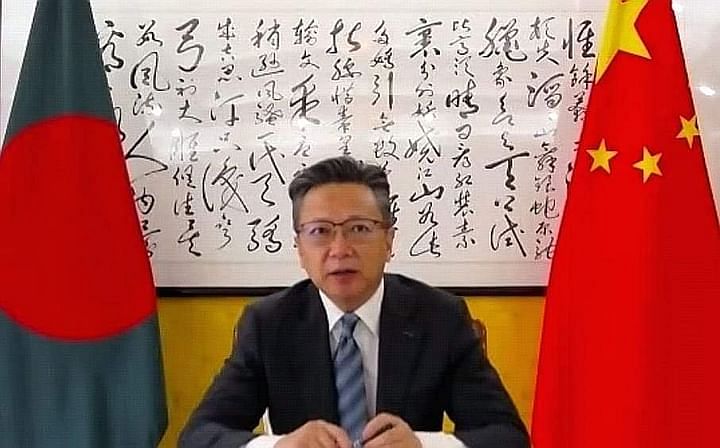Prothom Alo

The comment made by China’s ambassador in Dhaka to the effect that any involvement of Bangladesh in Quad will damage Dhaka-Beijing relations, created somewhat of a diplomatic commotion at home and abroad. Within just 48 hours of the comment, reactions and counter reactions came from Dhaka, Washington and Beijing. While Delhi issued no official reaction, the statement of the Chinese foreign ministry’s spokesperson came in response to a question posed by an Indian journalist. The bottom line is, the Chinese ambassador’s comment had created a stir.
The Chinese ambassador later made an explanation in an attempt to soften the note of warning in his comment about Bangladesh and Quad, but an article in the Global Times, the mouthpiece for the Chinese Communist Party’s foreign policy, and also the counter reaction of the Chinese foreign ministry’s spokesperson, did not serve to allay the tone of warning at all. In fact, the foreign ministry spokesperson attempted to justify the Chinese ambassador’s statement. He also rejected insinuations that China was trying to exert its influence on Bangladesh, saying that China never interfered in the internal affairs of any South Asian country. The significance of this statement is manifest in the fact that even before India, it was China that readily gave recognition to the controversial December 2018 election in Bangladesh. When it came to recognising the uncontested 5 January 2014 election, India had been ahead.
The matter of India and China both trying to draw Bangladesh into their respective spheres of influence, is a much discussed issue. The latest addition to this contest is Quad, the unofficial US-led coalition that also includes India, Australia and Japan. The strategic steps being taken to consolidate Quad, include questions of going ahead in the science, technology and trade competition, alongside military and defence cooperation. And it is no secret that that vaccine diplomacy is part of this. At the virtual summit of Quad leaders held on 12 March, pledges were made to extend all cooperation to India so that it would be able to manufacture 1 billion (100 crore) doses of the Covid vaccine by 2022. This move to boost India’s capacity is obviously an attempt to counter the possible diplomatic and market expansion of China’s vaccine.
It may be recalled that several companies of China had wanted Bangladesh’s involvement in the development of the Covid vaccine and a preliminary agreement had even been reached for Bangladesh’s participation in testing the efficacy of at least one of the vaccines. The Indian media reflected the discomfort of Indian diplomatic analysts about the matter. India at the time gained a bit of an upper hand, as it was manufacturing the Oxford-AstraZeneca vaccine. In the meantime, the proposal to participate in the tests for the Chinese vaccine was finally abandoned. But now that the Chinese vaccine has become indispensible, China has undoubtedly regained a foothold. That is why the Chinese ambassador had no qualms in criticising the delays in taking a decision about the vaccine.
In the scenario of global politics, it is necessary for us to closely observe the US in order to discern just how sudden is China’s impatience with the US’ new Asia-centric initiative, Quad. Power has changed hands in Washington and the Biden administration has made a 180 degree turn in many global policies. This is clear in the case of global warming and the UN agencies. But the Biden administration had not changed at all from predecessor Trump in one particular area and that is its China policy. This was obvious in the very first meeting between China and the Biden administration. There are still embargoes being placed against leaders of China’s Communist Party. There is a steady rise in the conflict with China over issues like Beijing’s control on several South China Sea Islands, recognition of Taiwan, Hong Kong’s democracy and repression of the Uighur Muslims. And for quite some time now, there have been discussions to put pressure on countries like Bangladesh, and also incentives, to join the Indo-Pacific Strategy coalition aimed at exerting US dominance in the Indian Ocean. An expansion of Quad also features prominently in discussions. China naturally feels added pressure and is going all out to draw Asian neighbours into its own camp.
After the statement made by the Chinese spokespersons, is there any reason to believe the Chinese ambassador’s statement was inadvertent? Whatever the reason may be, the fact remains that whether direct or indirect, threats are not conducive to friendship
This tug-of-war between Washington and Beijing certainly pushes Bangladesh towards a precarious balancing act. The stance of Bangladesh’s closest neighbour India is particularly significant in this context. Just as India and China are rivals in their efforts to gain regional dominance in Asia, the US wants to consolidate India’s position as an ally to look after its interests in Asia. Therefore it is only natural for China to watch Washington and Delhi’s movements with suspicion. And comments such as Bangladesh having ‘blood ties with India and economic ties with China,’ can certainly increase the concern. It is common knowledge that Bangladesh is historically dependent on China for military hardware. But in recent times Bangladesh has been showing interest in other sources of military weapons and equipment. Significant military supplies are coming in from western countries, particularly the US and its allies in the West.
Military supplies from the US is on a gradual rise. Mine resistant MRP vehicles have been procured from the US for use in the UN peacekeeping operations. Recently emergency WASP UAS drones have arrived for intelligence activities. Negotiations are on for the procurement of Apache helicopters and missiles. In a report on 22 September last year, Nikkei Asia detailed reasons why the US is stepping up initiatives for defence cooperation with Bangladesh. In its report, ‘US uses defence diplomacy to woo Bangladesh away from China,’ it said, “The US has stepped up efforts to entice Bangladesh into buying more of its military hardware in recent weeks, as it hopes to win over an ‘emerging’ ally in South Asia, where China has been expanding its economic influence.”
Just 10 days before this report, the US defence secretary at the time, Mark Esper, had telephoned prime minister Sheikh Hasina. This phone call took analysts by surprise on two counts. Firstly it was surprising that Trump’s outgoing administration would discuss such defence cooperation. Secondly, it was a rare instance that the defence secretary would discuss such a proposal directly. The US defence department’s bulletin that day stated that the two leaders had discussed an open and free Indo-Pacific region where the sovereignty of all countries was ensured, as well as issues pertaining to maritime and regional security, bilateral defence priorities and capacity development of Bangladesh’s armed forces. Both the leaders expressed their commitment to build up bilateral military ties with shared values and interests.
It is also no secret that India, an important ally in the US Indo-Pacific Strategy, is eager to meet Bangladesh’s military requirements. There is the USD 500 million (USD 50 crore) credit for the MOU signed to procure military weapons. India’s analysts were highly critical of China’s defence cooperation and still are overtly critical on this head. They used an accident of the Chinese training aircraft as an opportunity to question the quality and reliability of Chinese military equipment.
In this backdrop, the Chinese defence minister last December had shown interest at stopping over in Dhaka on the way to Nepal, but the plan was shelved at the last moment. He came to Dhaka exactly four months after that, but no details were available about any official discussion at a policymaking level. He had apprised the president about China’s stand on Quad. Around the same time, many foreign dignitaries and representatives, including the US special envoy on climate change John Kerry, visited Bangladesh and had talks at the top level of leadership.
The question is, have the big powers and the tensions of regional competition made China restive? Or was the warning of possible damages in relationship just a move to test the reactions? Were they wanting to observe the reactions of the US, India and Bangladesh? After the statement made by the Chinese spokespersons, is there any reason to believe the Chinese ambassador’s statement was inadvertent? Whatever the reason may be, the fact remains that whether direct or indirect, threats are not conducive to friendship.
* Kamal Ahmed is a senior journalist and columnist.
* This column appeared in the print and online edition of Prothom Alo and has been rewritten for the English edition by Ayesha Kabir










